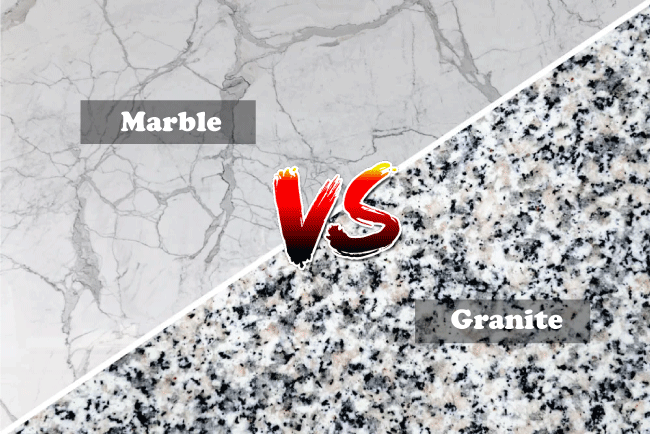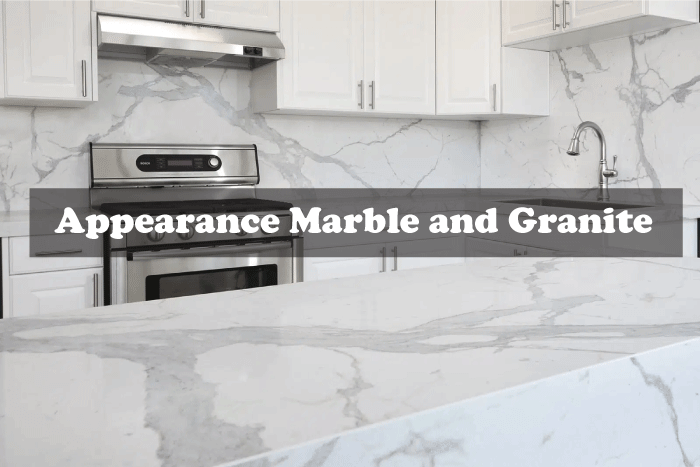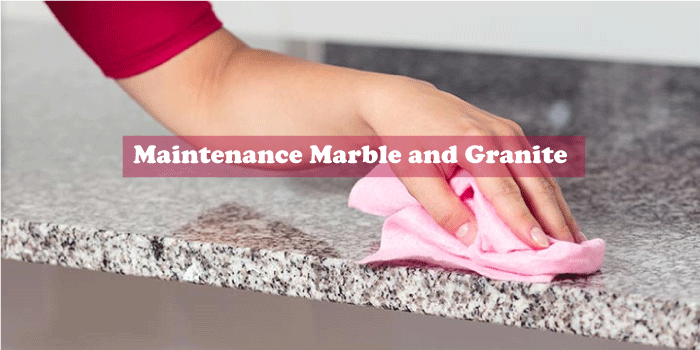Difference Between Marble and GraniteNatural stone is an excellent alternative for renovating your house's kitchen and bathroom countertop. It enhances the space's attractiveness, comes in various colors, can be made in almost any form or size, and blends seamlessly with any home décor, making it adaptable to any home decor. 
The most popular natural stone countertop options are granite and marble. Each material has advantages and disadvantages, so you must choose the one that best suits your requirements and budget. For instance, granite has a more raw aspect than granite, whereas marble has an exquisite appearance. Both materials may be expensive, with marble normally costing more than granite and typically needing expert installation because of their size and weight. Although granite and marble have many things in common, their look and functionality differ significantly. Let's examine the advantages and disadvantages of the two most common stone countertop selections in more detail. 
Some Key Points About Marble and Granite1. Appearance
With a smooth surface generally striated with mineral veins, marble is a metamorphic or sedimentary rock. Some marbles are made of quartz, whereas others are made of the greenish mineral serpentine. The most common shades of commercial marble are black and white. Granite is formed of silica, mica, feldspar, and quartz and is either metamorphic or igneous. It often has a packed, granular surface. The color ranges from light to dark and is shown as veins, dots, or solid patterns. Remember that the look of both kinds of stone differs across slabs based on where the stone was cut and where it came from in nature. 2. Maintenance
Many types of natural stone require varying maintenance, so homeowners should monitor the state of their bathroom or kitchen worktops. Granite is generally more maintenance-free, stain-resistant, and durable than marble. If granite is properly sealed after installation, water will bead on the surface. Every year, resealing should be carried out to provide a reliable and effective surface. Stone epoxy can be used to fix tiny cracks or scratches. However, remember that kitchens with a lot of activity or activity may require additional care. Marble should be treated carefully and regularly with a sealer formulated particularly for porous stone surfaces. Remember that marble is inherently susceptible to stains despite being sealed, so be careful to clean up spills as soon as they occur. Lemon juice, tomato sauce, and citrus are acidic liquids harmful to marble and can etch into the stone. 3. Long-Term Stability
While it's simple to assume that all stone is extraordinarily durable and practically unbreakable by nature, it's crucial to understand the complete picture. Although granite and marble are incredibly resilient, they must be sealed at least once a year to prevent liquids from slowly penetrating the stone. Although granite and marble are heat-resistant, you should always use caution (for example, avoid setting hot pots directly on the countertop surface). Marble is softer than granite, which resists chipping and scratches better. ConclusionUltimately, it all comes to personal choice and how the stone will be used. Marble is the best choice if you're willing to put some effort into maintenance. But granite is the best option if you want a natural stone that is more robust, scratch-resistant, and needs less maintenance. Common Questions about Marble and GraniteQuestion 1: How do marble and granite differ from one another? Answer: Most of the time, marble and granite may be identified by visible granules at the stone's surface. Granite looks flecked or grainy, whereas marble has veining. According to its composition, natural stone is divided into two broad categories: Siliceous stone is often exceedingly durable and simple to maintain since it is mostly made of silica- or quartz-like particles. Sandstone, slate, and granite all fall under this classification. Calcareous stone is comprised mostly of calcium carbonate. Unlike siliceous stone, it typically needs different cleaning techniques since it is susceptible to acidic cleaning agents. Marble, travertine, limestone, and onyx are examples of these stones. Question 2: Will granite crack? Answer: Natural stone is rare to crack with normal use and common sense protections. When being transported and installed, granite is most likely to break. This strong material won't be damaged by regular use. The counters made of natural stone should not be used for standing or sitting. Depending on how it is installed, individuals might need to support their countertop, particularly an island overhang. On the requirement for support, the stone supplier, fabrication team, and installation team should provide advice. Question 3: What is the origin of marble? Answer: Most marble stone comes from mines in Spain, China, India, and Italy. Together with the United States, other nations also have some marble. Question 4: Where does marble come from? Answer: Across the world, typically at tectonic plate borders, limestone can occasionally experience extremely high heat and pressure close to igneous granite. Some minerals in the rock recrystallize, transforming the rock. In addition, the initial carbonate minerals transform into calcite. Consequently, a lovely "interlocking carbonate crystal mosaic" is created. Several minerals present during the process give rise to various sorts of marble, which alter the marble's design and color. Question 5: Which are some Use of Marble? Answer: The following uses for marble slabs or marble tiles are possible:
Question 6: Does marble have scratches? Answer: Because marble is softer than granite and other stones, it can scratch even though it is extremely durable. Knives should not be used on it. The stone might damage the edge of your knife and scrape your worktop. Even hitting a large pot on the edge of a marble kitchen countertop might damage or break it. Customers frequently choose marble for spaces with less wear and tear, such as restrooms, workplaces, or fireplace surrounds. Question 7: What Marble types are there? Answer: Following are Marble types
Next TopicDifference Between
|
 For Videos Join Our Youtube Channel: Join Now
For Videos Join Our Youtube Channel: Join Now
Feedback
- Send your Feedback to [email protected]
Help Others, Please Share










